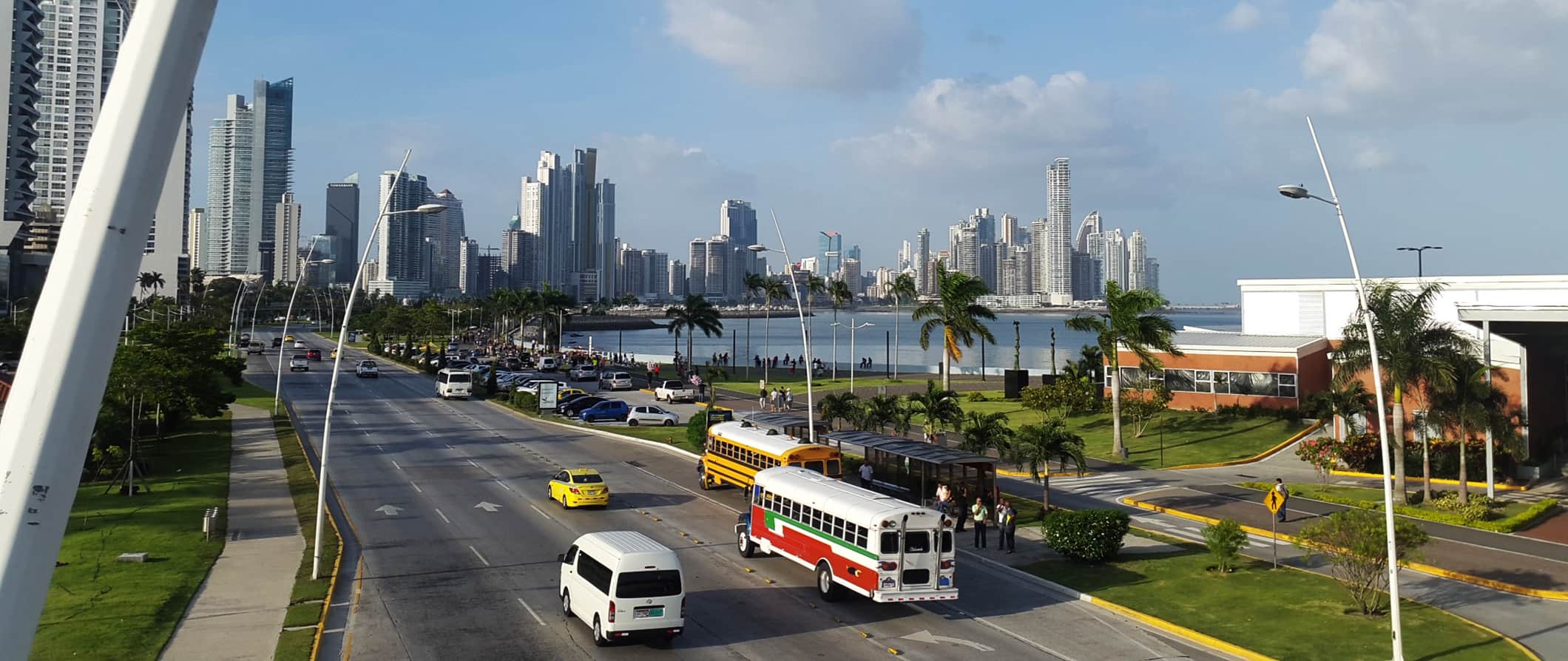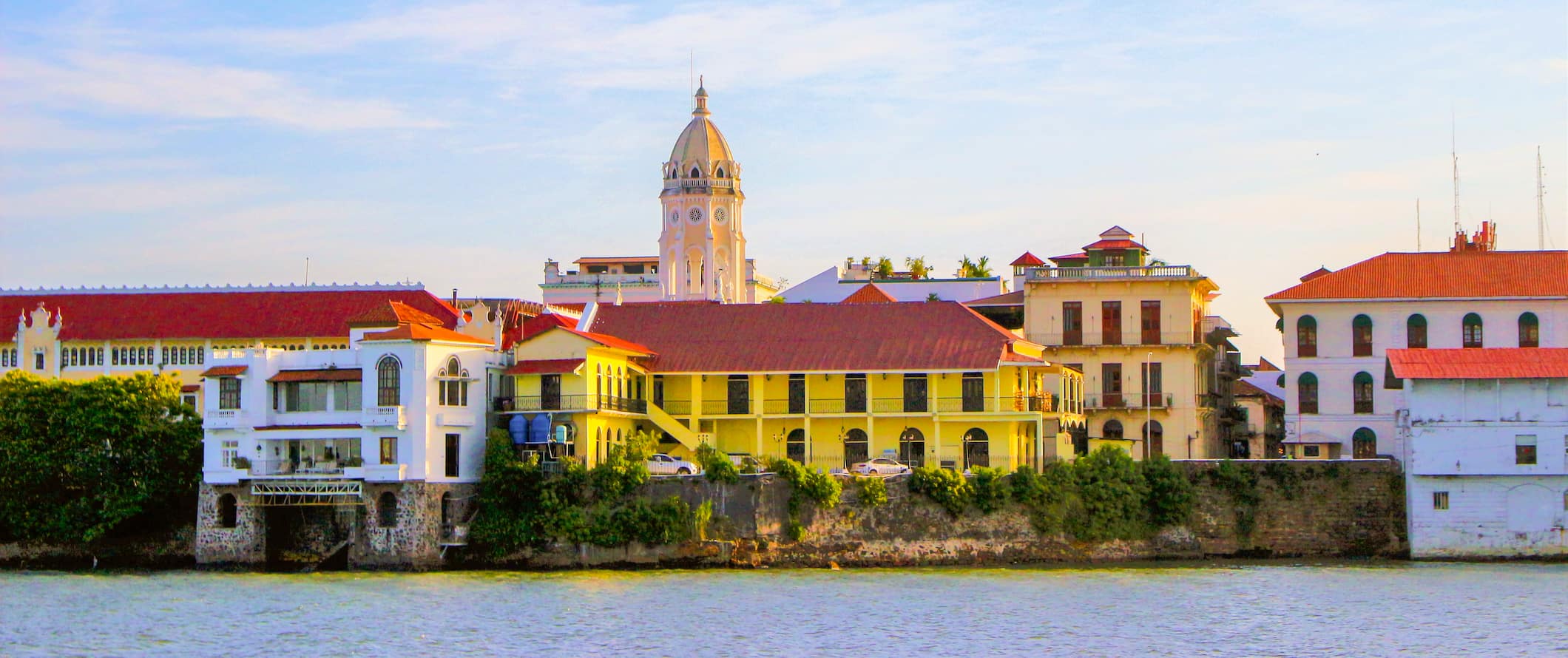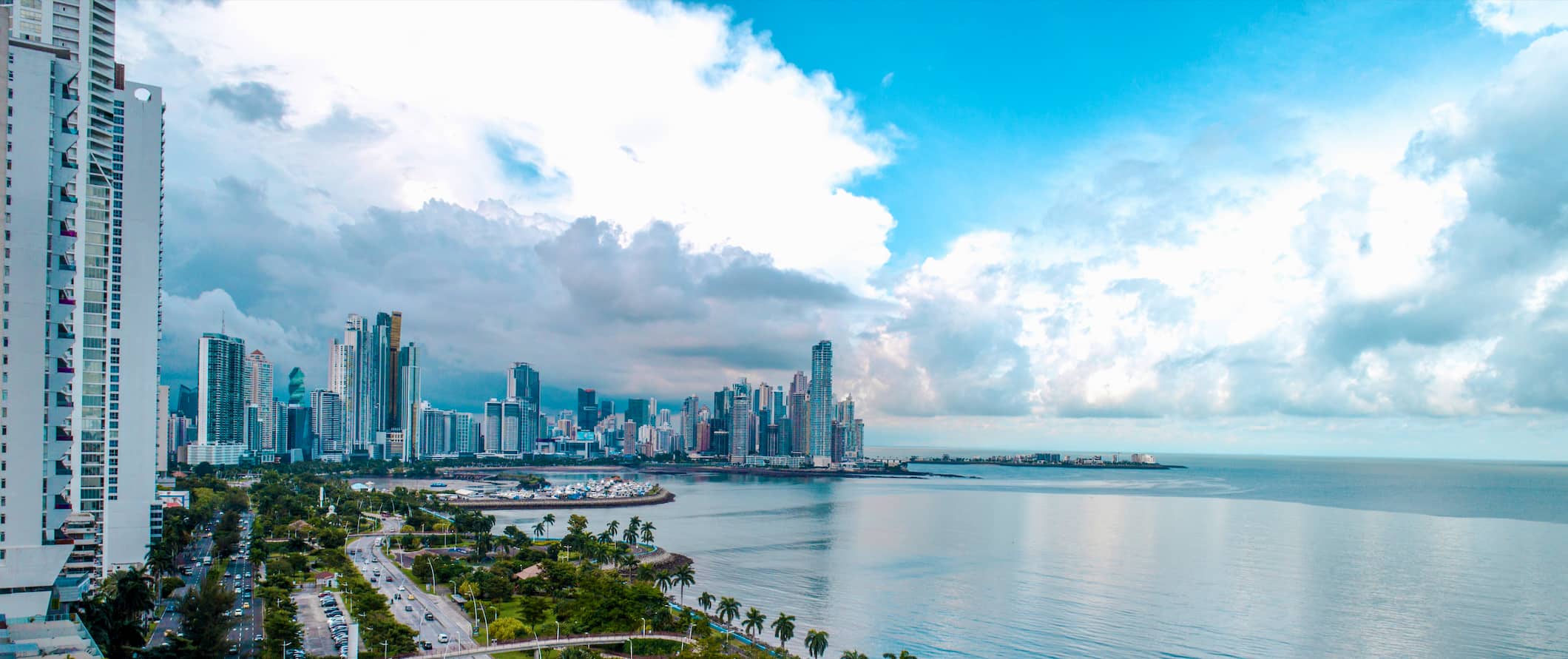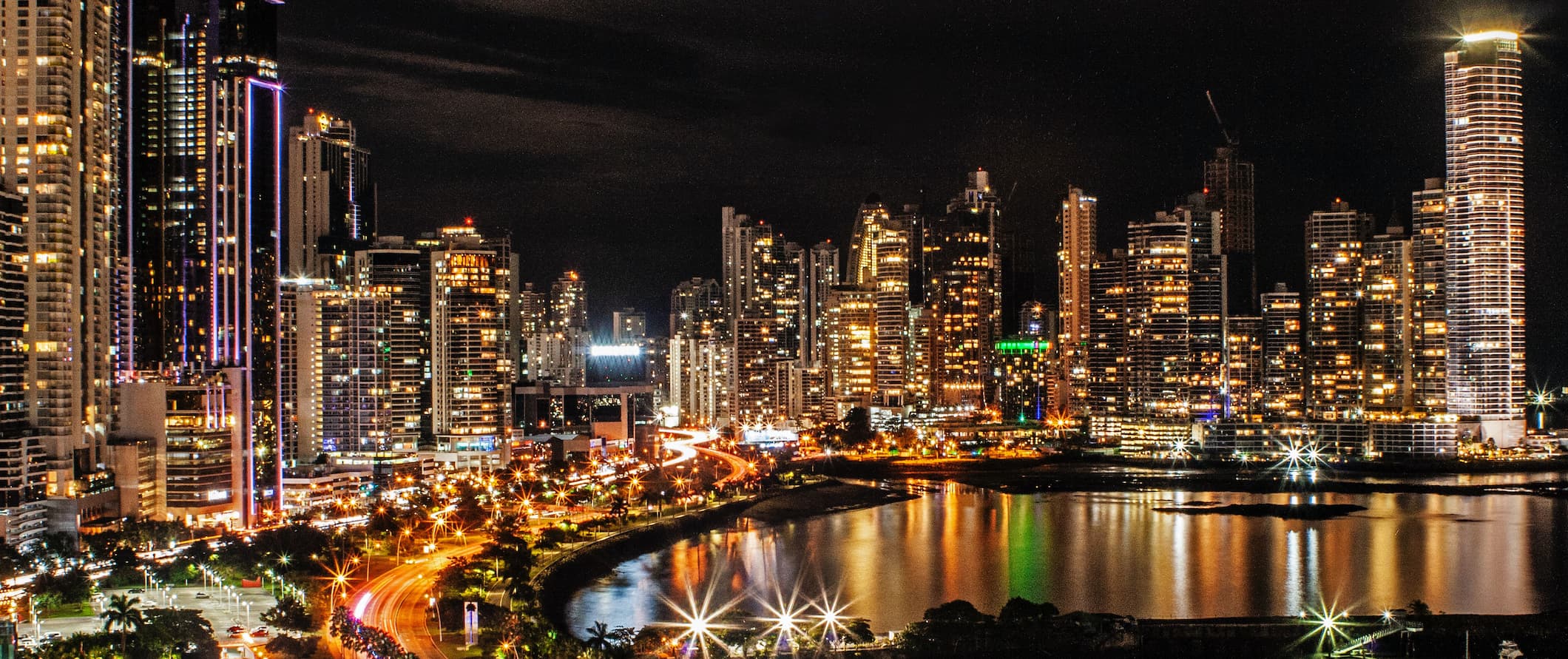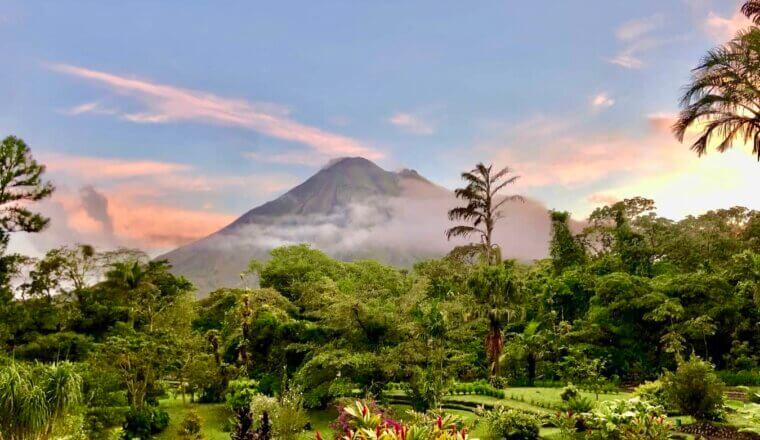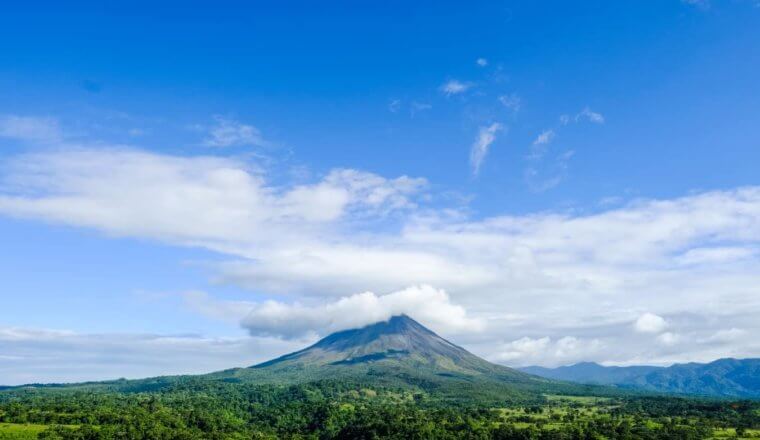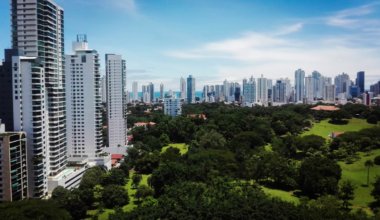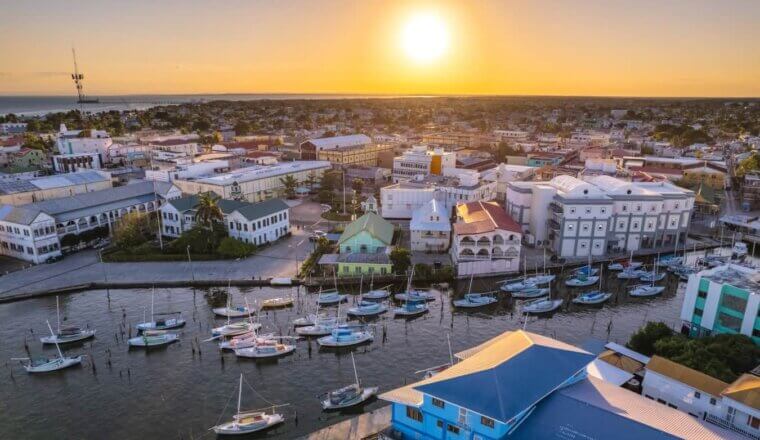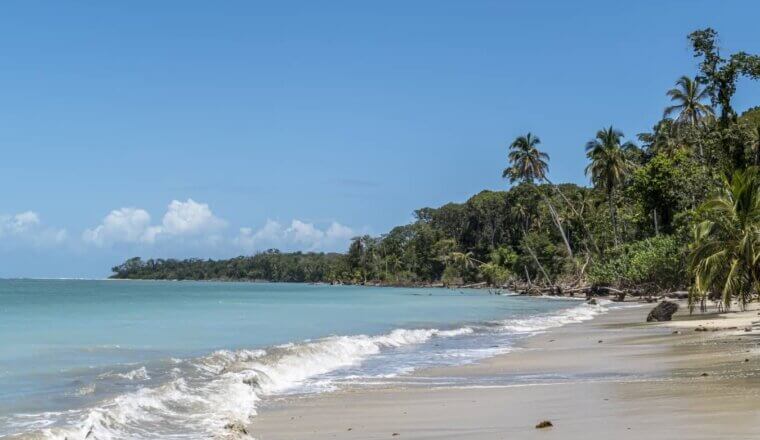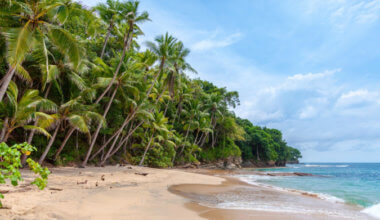Panama City is the most developed city in all of Central America and the financial and shipping hub of the region. The modern skyscrapers that have popped up in Panama City since the early 2000s showcase the city’s economic wealth and continuous growth.
Today, you can find divine food, plenty of shopping, and a vibrant nightlife scene in Panama’s capital. Casco Viejo, the oldest neighborhood of the city, is where you still find the early origins of the city when it served as an important trading hub between the New World and the Old World. Since the crumbling Spanish-colonial buildings of Casco Viejo were renovated in the 2000s, the area has evolved from a crime-ridden no-go neighborhood to Panama’s tourist hot spot.
Admittedly, Panama City doesn’t have a lot to offer in terms of landmarks and tourist sights, but it is a good place to spend a few days enjoying the amenities of a big city. It’s also a good base for visiting the Panama Canal, the rainforest, and nearby Taboga Island.
This guide to Panama City can help you plan your trip, save money, and make the most of your time in this massive capital city!
Table of Contents
Top 5 Things to See and Do in Panama City
1. Wander Casco Viejo
Casco Viejo, the original Spanish-colonial settlement built in 1671, is a must-do and also a great place to stay if you’d rather not stay in the bustling metropolis part of the city. Everything is walkable in this gorgeous neighborhood that is home to some of the trendiest bars, restaurants, and boutique hotels. Visit the Panama Canal Museum for a bit of history as well as the Museo de la Moda to learn about the unique, vibrant tapestries made by the Guna indigenous people. You can also wander the cobblestone streets and watch the sunset at one of the many rooftop bars. If you’re a coffee fanatic and want to indulge, head to Café Unido.
2. Hang out in Metropolitan Park
The Metropolitan Park is a 575-acre rainforest within the city limits. This beautiful nature sanctuary is home to 227 bird species, 45 mammals, 14 kinds of amphibians, 36 different kinds of snakes, and 284 types of trees. There are 8 kilometers (5 miles) of trails here to enjoy and you can hike up to the top of Cedar Hill for beautiful panoramic views of the city and the Panama Canal. Admission is $4 USD. You can also see 30 different species of butterflies housed on the butterfly farm for an additional $5 USD.
3. See the Panama Canal
One of the 7 Wonders of the Modern World, the Panama Canal is definitely worth checking out if you’re in Panama City. The Miraflores Locks are one of twelve locks along the Panama Canal and the closest to Panama City. The canal took 10 years and over 40,000 laborers to build (over 5,000 of whom died during construction). There is a visitor center with an observation deck and, every time a ship passes through the canal, you’ll hear a detailed explanation of what is happening. Also, Miraflores has an interesting IMAX documentary on the history of the Canal with Morgan Freeman narrating. Admission is $20 USD.
4. Explore Panama Viejo
Panama Viejo (Old Panama) is a UNESCO Cultural World Heritage Site and forms the original part of the city. It was founded in 1519 by Pedrarías Dávila and was the first Spanish settlement on the Pacific Coast of the Americas — and the first planned town in the Western Hemisphere. In 1691, the city was attacked and destroyed by pirate captain Sir Henry Morgan. Despite several attacks, a huge fire, and an earthquake, you can still see some of the ruins of many of the original buildings including the Old Panama Cathedral. The remaining ruins are spread out over 57 acres, including the original cathedral. Admission is $15 USD.
5. Bike along Amador Causeway
Amador Causeway is made up of rocks excavated for the construction of the Panama Canal and connects Panama City with three small islands: Naos, Perico, and Flamenco. The 6-kilometer (4-mile) ultra scenic, colorful boardwalk is popular with cyclists and filled with all kinds of restaurants where you can stop for fresh seafood and take in the views (especially at sunset). You can rent bikes for about $15 USD per day if you want to explore by bike.
Other Things to See and Do in Panama City
1. Check out Mi Pueblito
This open-air museum is designed to give visitors a glimpse of village life in Panama. You’ll find replicas of colonial and indigenous buildings here and on Fridays and Saturdays they have folklore dance performances. The village is divided into three parts: an indigenous village, a rural village, and an Afro-Antillean village, showing aspects of these three different population groups in Panama. Admission is $3 USD.
2. Admire some colonial art
The Museo de Arte Religioso Colonial in Casco Viejo houses colonial religious art that dates back to the 16th century. Some of the art and artifacts even made it through the attack and sacking of the city by Henry Morgan and his crew in 1671. One of the most interesting pieces is the Arco Chato, a long arch that stood unsupported for hundreds of years (the arch was used to prove that Panama was not earthquake-prone, making it an ideal place for the canal rather than Nicaragua). This is a small museum and admission is only $1 USD, so it’s worth a quick visit.
3. Take a ferry to Taboga Island
Taboga Island is a little island 19 kilometers (12 miles) off the Pacific coast of Panama City. It’s easy to do as a day tour, with return ferries costing $24 USD. The ferries leave from Amador Causeway and the ride takes about 30 minutes. Explore the island’s village, chat with the locals, go on a hike, or just chill on the sandy beach. The beach is not the nicest as the water tends to be polluted but the ocean views towards Panama City and the Panama Canal make up for that.
4. Hike Cerro Ancon
The highest hill in Panama City makes for a great hike. It’s a steep 30-minute incline, but you’ll be rewarded with fantastic views. There are two viewing platforms: one facing historic Casco Viejo, and one facing the newer skyline that’s lined with skyscrapers. Look out for wildlife along the way – you’re likely to see toucans, iguanas, and pacas. A cab ride to the trailhead, which is right by Mi Pueblito, takes about 10 minutes.
5. Marvel at contemporary art
The Museum of Contemporary Art in Panama City features various permanent and temporary exhibits from Panamanian and Latin American artists. With over 700 items in the collection, it offers a comprehensive introduction to Latin American contemporary art. There are often free exhibits that provide an opportunity to hang out with the city’s artsy crowd too. It’s the only contemporary art museum in the entire country. Admission is $5 USD.
6. Take a Spanish course
If you’ve got some time to spend in the city, consider taking a week-long Spanish course. There are a number of schools here that offer programs with one-on-one or small group classes for $230-$250 USD per week. Try the Spanish Panama Language School or Casco Antiguo Spanish School for in-depth lessons that can help you master the language.
7. Learn about Marine Life
Punta Culebra Nature Center is a science and nature center run by the Smithsonian Tropical Research Institute that focuses on marine life. There is also a short nature trail with three-toed sloths, iguanas, and frogs. Explanatory signs are in Spanish and English, making it an educational exhibition that’s interesting for grown-ups and kids alike. Admission is $8 USD.
8. Visit the Biomuseo
The Biodiversity Museum was designed by renowned architect Frank Gehry and it was his first design in Latin America (Gehryd designed the Dancing House in Prague, the AGO in Toronto, and the Disney Concert House in LA) . It’s worth seeing simply for the stunning design, though spending a couple of hours inside the museum is a great way to learn about Panama’s biodiversity. The museum also highlights the natural and cultural history of the country. The Biomuseo has eight galleries for its permanent exhibits, each one covering a different topic. Tickets are $18 USD.
9. Check out the seafood market
Panama’s lively Mercado de Mariscos, the seafood market, is located on the western end of the Cinta Costera, the coastal road that connects Casco Viejo with the newer part of town. The market is divided into two parts: one section is where fresh fish and seafood are sold, and the other section is where you’ll find dozens of no-frills seafood restaurants where you can try some of the fresh catch. Try the local specialty, ceviche, made from raw fish and lemon.
10. Stroll Avenida Central
Avenida Central is the pedestrian walkway where you can soak up the city’s vibe. It’s noisy and fun, with lots of street food vendors and performers, making for some excellent people-watching. Cinta Costera is the city’s waterfront park area where you can enjoy views of the ocean while grabbing an ice cream or some street food as you soak up the pace of the city.
Panama City Travel Costs
Note: Panama uses both PAB and USD. There’s no real need to carry the local currency, the Panamanian Balboa, unless you’re paying for really small things on the street. For the most part, use USD (which has the same value as PAB).
Hostel prices – Hostels in Panama City are inexpensive, with a night in a hostel dorm costing between $12-30 USD per night for a 6-8-bed dorm. Private rooms start around $22 USD per night for a double room. All hostels offer free Wi-Fi and some offer free breakfast.
Budget hotel prices – For a three-star hotel, prices start at $50 USD per night and go up from there. International hotel chains range from $75-135 USD.
Airbnb is available in the city, with private rooms ranging from $40-60 USD per night and entire apartments starting around $75-100 USD. Bigger apartments accommodating four to six people start at $150 USD per night. Book early otherwise prices can double.
Food – Like its neighbors, Panamanian cuisine features rice, black beans, yuca (a starchy vegetable similar to the potato), plantains, beef, chicken, and seafood. Common dishes include empanadas, chicken and rice, fried fish, and ceviche (a raw fish dish with lemon).
Local food stalls meals will cost around $4-6 USD. For that price, you will get a plate of chicken, rice, and beans — a staple dish in Panama. Western food such as pizza or hamburgers costs around $10-15 USD.
Panama City has the best international food in all of Central America, so take advantage of that while you’re in town. Many of the trendiest restaurants can be found in the Casco Viejo neighborhood, such as the Dining Room, Tantalo (a superb rooftop restaurant and bar atop the Tantalo Hotel), Donde Jose (fine dining Panamanian cuisine) and Casa Casco, which has three great restaurants, a rooftop bar and a nightclub. You’ll also find a number of great restaurants along Amador Causeway.
For a nice meal with wine, expect to pay around $50 USD. There are a lot of stylish, more expensive restaurants in Casco Viejo if you’re looking for something more upscale.
Domestic beer at a bar is around $2.50 USD. Cocktails at one of the popular rooftop bars are around $8-9 USD. A latte/cappuccino costs around $3.50 USD while bottled water is $1 USD.
If you plan on cooking your own food, expect to pay about $35-45 USD per week for groceries like rice, beans, seasonal produce, and some meat or fish.
Backpacking Panama City Suggested Budgets
If you’re backpacking around Panama City, expect to spend about $45 USD per day. This includes staying in a hostel dorm, limiting your drinking, cooking your meals, using public transportation to get around, and doing mostly free and cheap activities like hiking and wandering the Old Town.
On a mid-range budget of around $150 USD per day, you can stay in a private Airbnb, enjoy a few drinks, eat out for a few meals, take the occasional taxi, and do some paid activities like visiting the canal.
On a “luxury” budget of $220 USD per day or more, you can stay in a hotel, eat out for all your meals, drink more, take more taxis, and do whatever tours and activities you want. This is just the ground floor for luxury though. The sky is the limit!
Panama City Travel Guide: Money-Saving Tips
Panama City is a pretty affordable place to visit. Unless you are dining on the higher end of things or staying in a chain hotel, you’re hard pressed to spend a lot of money here. However, there are always extra ways to keep your costs down. Here are the best ways to save money in Panama City:
- Stick to free activities – Most of Panama City’s sights can be visited for free: Casco Viejo, Amador Causeway, a stroll through the fish market and along Cinta Costera, the coastal road that offers stunning views of the bay and the freighters entering the Panama Canal.
- Eat at local food stands – Meals at local food stalls cost less than $5 USD. You’ll get rice, chicken, beans, and maybe another side plus a drink. Don’t expect a super tasty meal, but it is enough to fill you up.
- Avoid taxis – Buses are cheap and go everywhere in the city. Take the bus and save your money!
- Bring a water bottle – The tap water here is generally safe to drink so bring a reusable water bottle. LifeStraw is my go-to choice as it has a built-in filter to ensure your water is always clean and safe.
- Stick to beer – Beer is cheaper than other kinds of alcohol so if you want to drink, stick to beer.
- Save money on rideshares – Uber is cheaper than taxis and is the best way to get around if you don’t want to wait for a bus or pay for a taxi.
- Carry small change – Most taxis and small shops won’t accept larger bills for small purchases so make sure you carry change.
- Avoid hot water – Get rooms with cold-water showers. Hot water always costs a lot more. It’s so hot here anyway, you’ll hardly ever want hot water. Even I got used to cold-water showers, and usually, I get cranky without hot water!
- Stay with a local – There are tons of Couchsurfing hosts (and lots of community events) here, making this a great city to Couchsurf in. Pick up some tips and save some money by staying with a local!
Where to Stay in Panama City
Panama City has plenty of fun, affordable hostels. Here are my favorite places to stay:
How to Get Around Panama City
Panama City has some areas that are walkable – for example, the popular Casco Viejo neighborhood and Amador Causeway – but it is quite spread out and the constant heat and humidity can make walking around all day challenging. Luckily, public transport is easy to use and cheap.
Public transportation – It is easy to travel by city bus between Amador Causeway and Casco Viejo – buses have their destination written on the front. The main bus terminal is inside the Albrook Shopping Mall. If you think you’ll be taking the bus a lot, pick up a metro card at Albrook Terminal. The metro card is $2 USD, and then you can add however much money you think you’ll need. Since a bus ride is only $0.35 USD, adding only one dollar will get you four rides.
To recharge the card, you have to find a supermarket that offers this service (look for a sign that says Venta de Tarjeta y Recarga) or head to Albrook Terminal. You’ll be able to navigate the bus system with the help of Google Maps.
Panama City’s first metro line opened in 2014 (the first metro system in all of Central America), but it is pretty irrelevant for tourists since it’s far away from the beaches and interesting sights. A ride is only $0.35 USD. The metro runs from 6am-10pm daily (even on holidays), with 14 different stations, running north and south and passing through the city center.
Bicycle – Cycling in Panama City is possible, but not very safe since Panama is known for its notorious drivers who often speed. The only places you can safely cycle at are Amador Causeway (where you’ll find several bike rental places) and Cinta Costera, the coastal beltway that links modern Panama City with the historic Casco Viejo neighborhood. You can rent bikes for about $15 USD per day.
Taxi – Taxis are cheap in Panama City. Be careful though: Panamanian cab drivers are known to try to rip off foreigners. Make sure to always negotiate your fare before the start of the trip, since the taxis don’t use meters. Note that taxis are cash only.
Ridesharing – Uber is available in Panama City and is cheaper than taxis, so stick to using it if you need a ride.
Car rental – You won’t need a car to get around the city, however, they can be helpful for exploring the region if you plan on leaving the city. Rentals can be found for as little as $25 USD per day for a multi-day rental. Most rental agencies require drivers to be at least 25, though some will accept drivers at 21 if they have a credit card.
For the best car rental prices, use Discover Cars.
When to Go to Panama City
Panama City has a short dry season between January and May, which is when there is little rain and you’ll get to enjoy clear blue skies. But since Panama is located only nine degrees north of the equator, temperatures are pretty consistent year-round.
The lowland regions, including Panama City, are always hot and humid. Daytime temperatures average 30-33°C (86-91°F), nighttime temperatures are around 21-23°C (69-73°F).
Rainy season in Panama lasts from mid-April to mid-December, but it usually only rains from late afternoon into the night, which means mornings and early afternoons can still be enjoyed. The rainiest month is November, and July and August are the months that see the least rain during the wet season. If you visit during the rainy season, pack a rain jacket and an umbrella.
You never have to deal with peak season crowds in Panama City – it never feels crowded, unless you run into a cruise ship tour group on one of the days a cruise ship docks in the port. The good news is that the cruise ships docking here are relatively small and that they usually depart at 5pm.
The only times of year that accommodation can book up (especially affordable hotels/Airbnbs) are during holidays and in February during Carnaval. If you’re planning to visit Panama City in February, look up the dates of Carnaval to avoid crazy crowds and inflated prices.
How to Stay Safe in Panama City
Panama City is generally safe but pickpocketing can occur, especially on city buses. Always be vigilant and don’t carry more cash on you than you’re planning to spend. Leave your passport and credit cards (other than the one you may be using) back at the hostel/hotel, don’t carry valuables in your purse.
Bag snatching also happens in Panama City – both on the street and in restaurants — so don’t leave your bag sitting on the chair next to you.
If you go out in Casco Viejo at night, but your hotel is in the newer part of Panama City, take a taxi or Uber back to your hotel. The El Chorillo neighborhood, adjacent to Casco Viejo, can be a bit sketchy after dark.
When taking taxis, negotiate the fare before the trip, or you might get ripped off. There have been frequent reports by foreigners about being overcharged for cab rides. If you don’t want to communicate with the driver or you don’t have cash on you, call an Uber via the app.
Keep an eye out for common scams against tourists, such as fake ATMs, taxis that don’t use a meter, and questionable tour operators.
Solo female travelers should generally feel safe here, however, the standard precautions apply (never leave your drink unattended at the bar, never walk home alone intoxicated, etc.).
If you experience an emergency, dial 911.
Always trust your gut instinct. Avoid isolated areas at night, and be aware of your surroundings at all times. Make copies of your personal documents, including your passport and ID, before you leave on your trip.
The most important piece of advice I can offer is to purchase good travel insurance. Travel insurance will protect you against illness, injury, theft, and cancellations. It’s comprehensive protection in case anything goes wrong. I never go on a trip without it as I’ve had to use it many times in the past.
Panama City Travel Guide: The Best Booking Resources
These are my favorite companies to use when I travel. They consistently have the best deals, offer world-class customer service and great value, and overall, are better than their competitors. They are the companies I use the most and are always the starting point in my search for travel deals.
- Skyscanner – Skyscanner is my favorite flight search engine. They search small websites and budget airlines that larger search sites tend to miss. They are hands down the number one place to start.
- Hostelworld – This is the best hostel accommodation site out there with the largest inventory, best search interface, and widest availability.
- Booking.com – The best all around booking site that constantly provides the cheapest and lowest rates. They have the widest selection of budget accommodation. In all my tests, they’ve always had the cheapest rates out of all the booking websites.
- Get Your Guide – Get Your Guide is a huge online marketplace for tours and excursions. They have tons of tour options available in cities all around the world, including everything from cooking classes, walking tours, street art lessons, and more!
- SafetyWing – Safety Wing offers convenient and affordable plans tailored to digital nomads and long-term travelers. They have cheap monthly plans, great customer service, and an easy-to-use claims process that makes it perfect for those on the road.
- LifeStraw – My go-to company for reusable water bottles with built-in filters so you can ensure your drinking water is always clean and safe.
- Unbound Merino – They make lightweight, durable, easy-to-clean travel clothing.
- Top Travel Credit Cards – Points are the best way to cut down travel expenses. Here’s my favorite point earning credit cards so you can get free travel!
Panama City Travel Guide: Related Articles
Want more info? Check out all the articles I’ve written on backpacking/traveling Central America and continue planning your trip:
